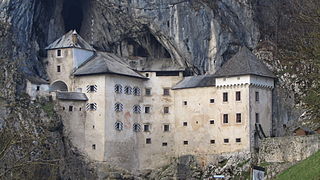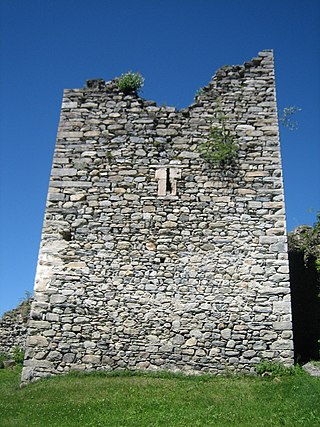Architectural history
The castle's basic fabric comes mainly from the first half of the 15th century. In the middle of the 16th century it was rebuilt in Renaissance style. The former three-storey building includes two corner towers formerly equipped with canopies, one of which was decorated with a frieze with sandstone ornaments, mythical creatures, human heads, and a stair tower. The Renaissance portal is adorned with the emblem of the Palant family and the date 1464.
Inside the house is a barrel-vaulted basement, a tower room with a star vault, and a fireplace from the Renaissance. By 1800, the basic structure had been significantly reduced, and the fortification, except for the main wing, was dismantled.

Cardiff Castle is a medieval castle and Victorian Gothic revival mansion located in the city centre of Cardiff, Wales. The original motte and bailey castle was built in the late 11th century by Norman invaders on top of a 3rd-century Roman fort. The castle was commissioned either by William the Conqueror or by Robert Fitzhamon, and formed the heart of the medieval town of Cardiff and the Marcher Lord territory of Glamorgan. In the 12th century the castle began to be rebuilt in stone, probably by Robert of Gloucester, with a shell keep and substantial defensive walls being erected. Further work was conducted by the 6th Earl of Gloucester in the second half of the 13th century. Cardiff Castle was repeatedly involved in the conflicts between the Anglo-Normans and the Welsh, being attacked several times in the 12th century, and stormed in 1404 during the revolt of Owain Glyndŵr.

Herborn is a historic town on the Dill in the Lahn-Dill district of Hesse in Germany. Before World War I, it was granted its own title as Nassauisches Rothenburg. The symbol or mascot of this town is a bear. Scenic attractions include its half-timbered houses; Herborn is located on the German Timber-Frame Road. Herborn hosted the 26th Hessentag state festival in 1986, and the 56th Hessentag in 2016.

Gentbrugge is one of 25 districts ("wijken") of the city of Ghent, Belgium in the Flemish Region of Belgium. Gentbrugge together with Oud Gentbrugge had been a separate municipality before 1 January 1977, when it fused with Ghent.

Arenberg Castle is a Flemish Renaissance style château in Heverlee, close to Leuven, Belgium. It is surrounded by a park.

Trausnitz Castle is a medieval castle situated in Landshut, Bavaria in Germany.

Kranenburg is a town and municipality in the district of Cleves in the state of North Rhine-Westphalia, Germany. It is located near the border with the Netherlands, 12 kilometres (7 mi) south-east of Nijmegen and 11 kilometres (7 mi) west of Cleves.
The Architecture of Hungary is understood as the architecture of the territory of the country of Hungary, and in a wider, of the Kingdom of Hungary, from the conquest to the present day.

Predjama Castle is a Renaissance castle built within a cave mouth in south-central Slovenia, in the historical region of Inner Carniola. It is located in the village of Predjama, approximately 11 kilometres from the town of Postojna and 9 kilometres from Postojna Cave.

The Château de Pontevès is a ruined castle in the commune of Pontevès in the Var département in Provence, southern France.

Vianden Castle, located in Vianden in the north of Luxembourg, is one of the largest fortified castles west of the Rhine. With origins dating from the fourth century as a Roman outpost and the 10th century, the more familiar castle form was built in the Romanesque style from the 11th to 14th centuries. Gothic transformations and trimmings were added at the end of this period. A Renaissance mansion was added in the 17th century but thereafter the castle was allowed to fall into ruins. It has, however, recently been fully restored and is open to visitors.

Brežice Castle is a 16th-century castle in the town of Brežice, in southeastern Slovenia, at the street address Cesta prvih borcev 1.

Forchtenstein Castle is a castle built in the Late Middle Ages near the municipality of Forchtenstein in northern Burgenland, Austria. Forchtenstein Castle is 511 metres (1,677 ft) above sea level.

Burg Raabs an der Thaya is a castle in municipality Raabs an der Thaya, Lower Austria, Austria, built in the second half of the 11th century, it is 456 metres (1,496 ft) above sea level.

Burg Krems is a castle in Styria, Austria. Burg Krems is 330 metres (1,080 ft) above sea level.

Ansembourg Old Castle, known as the Old Castle of Ansembourg, in central Luxembourg is one of the castles belonging to the Valley of the Seven Castles. Located high above the little village of Ansembourg, the medieval castle is the private residence of the current Count and Countess of Ansembourg.

The Volčji Potok Arboretum was opened to the public in 1952. It originally formed part of the Souvan family estate in 1885, which was taken over by the University of Ljubljana in 1952 and legally declared a place of cultural and natural heritage of national importance. Now independent of the university, it is the most visited botanical garden in Slovenia and in recent years has become well known for its spring flower shows. The arboretum is primarily a botanical garden for woody plants, the only one in Slovenia.

Castels Castle is a castle in the municipality of Luzein of the Canton of Graubünden in Switzerland. It is a Swiss heritage site of national significance.
Nütterden is a village in the municipality of Kranenburg, Kreis Kleve in the German State of North Rhine-Westphalia.

Near the Eifel town of Manderscheid are the ruins of two castles, the castles of Manderschied, whose history and location reflect the mediaeval conflict of interest between the Electorate of Trier and the Duchy of Luxembourg.

Pyrmont Castle stands west of Münstermaifeld near Roes and Pillig on a slate rock outcrop above a waterfall on the Elzbach in the southern Eifel mountains in Germany. It is in the municipality of Roes in the district of Cochem-Zell.


















